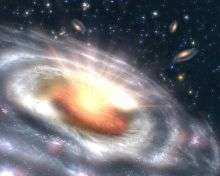October 13, 2014 report
Researcher devises a new way to mimic Hawking radiation in a lab

Physicist Jeff Steinhauer, with the Technion-Israel Institute of Technology in Israel has devised a means for mimicking Hawking radiation in his lab. In his paper published in the journal Nature Physics, he describes what he did in his lab and why he believes his experiments likely mimic real Hawking radiation. Giovanni Modugno offers a News & Views piece on the work in the same journal issue.
Hawking radiation, it is believed, occurs when one of a matter/anti-matter particle pair is pulled into a black hole and the other is not, leaving the one that isn't, to flow freely in space. The idea was first proposed by famed physicist Stephen Hawking back in 1974, and ever since, physicists have been trying to either detect it emanating from a black hole, or recreate it in a lab somehow. Thus far, no one has been able to do either, though Steinhauer claims his work comes very close.
Steinhauer's experiments are based on the theory that quantum fluids should be able to mimic what happens at a black hole's event horizon—to that end, he uses sound rather than light. He first cooled several rubidium atoms to just above absolute zero, causing them behave as a single fluid quantum object. Next, he used a laser to cause the fluid to move—faster than sound travels. This caused sound waves to become trapped, mimicking the impact of gravity within a black hole. The setup resulted in pairs of sound waves being created and just as suddenly disappearing, mimicking the matter/anti-matter particles near a black hole. And just like the black hole, sometimes one of the paired particles was pulled in, while the other was not—mimicking Hawking radiation. Steinhauer then amplified the amount of "radiation" by setting up a secondary event horizon, which caused the free sound waves to bounce back and forth, building up enough to allow for measurement.
While Steinhauer's experiments do clearly mimic action described by Hawking's theory, it's still not exactly clear if what he's done truly mimics what occurs with real black holes. Undaunted, he is continuing with the work, hoping to devise a method that doesn't require amplification, which would more closely resemble real black holes. Whether the experiments conducted by Steinhauer truly mimic black holes or not, it appears likely that what he's done has not only furthered the science and given more credence to Hawking radiation, but it's also laid a path for more research in the future.
More information: Nature DOI: 10.1038/nature.2014.16131
Journal information: Nature , Nature Physics
© 2014 Phys.org




















